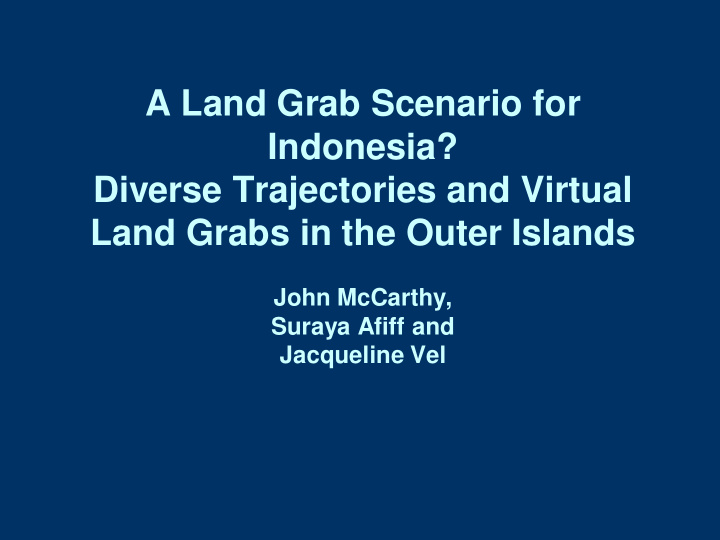



A Land Grab Scenario for Indonesia? Diverse Trajectories and Virtual Land Grabs in the Outer Islands John McCarthy, Suraya Afiff and Jacqueline Vel
Merauke Food Estate - Papua koran-jakarta.com http://farmlandgrab.org/
transnational land grabbing in Indonesia – To what degree is the scenario happening? – What kind of scenario?
Define land grabbing 1. grasping, seizure or capture of land in an unacceptable or illegitimate fashion at the expense of the poor. 2. long-term control of large landholdings to supply the food and energy needs
Trajectories of tenurial transformations 1. technology and infrastructure develops, resources that can be extracted or utilised 2. market opportunities practices of extraction 3. Reworking of state laws: revenue & accumulation 4. a series of redefinitions landscape
transformations 1. colonial plantation development, 2. markets for timber & technologies to exploit forests 3. large-scale government administered colonisation project 4. private palm oil & timber estates 5. market for biofuels, rising value of agricultural commodities & carbon
But…. – schemes bump into • existing land uses • ecologies • shifting political economies » fluctuations in commodity prices Problematic – resisted, only partially realised. often ‘virtual’ – permit grabbing
Central Kalimantan: The one million hectare project
Constraints… – the social and political processes of commodity production shape how plans work out in a particular context • Legitimacy & food security • Separatism • fuzzy land tenure arrangements: overlapping statutory and embedded rights
Jatropha in East Indonesia (NTT)
Pattern of failed jatropha plantations • main domestic actors - Capture linked budgets & subsidies - rents associated with investments - land grabbing by international companies?
Land grab scenarios & oil palm
Liberalization of plantation laws Smallholder plasma 70% 70:30 model Nucleus estate 30% Nucleus estate <80% Smallholder plasma 20:80 model <20%
Conclusions – projects/plans/booster rhetoric vs what actually occurs – political, economic, cultural limiting factors – ‘double movement’ – Differences in timing, scale & mode of transformation – Fragmented, differentiated, decentralized – continuity rather than disjunction – Reinvestment in smallholder agriculture??
Recommend
More recommend